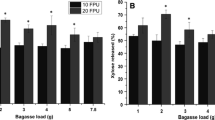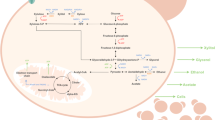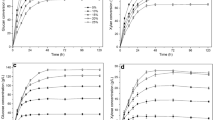Abstract
Propionic acid, a widely used food preservative and intermediate in the manufacture of various chemicals, is currently produced from petroleum-based chemicals, raising concerns about its long-term sustainability. A key way to make propionic acid more sustainable is through fermentation of low-cost renewable and inedible sugar sources, such as lignocellulosic biomass. To this end, we utilized the cellulosic hydrolysate of sweet sorghum bagasse (SSB), a residue from a promising biomass source that can be cultivated around the world, for fermentative propionic acid production using Propionibacterium freudenreichii. In serum bottles, SSB hydrolysate supported a higher propionic acid yield than glucose (0.51 vs. 0.44 g/g, respectively), which can be attributed to the presence of additional nutrients in the hydrolysate enhancing propionic acid biosynthesis and the pH buffering capacity of the hydrolysate. Additionally, SSB hydrolysate supported better cell growth kinetics and higher tolerance to product inhibition by P. freudenreichii. The yield was further improved by co-fermenting glycerol, a renewable byproduct of the biodiesel industry, reaching up to 0.59 g/g, whereas volumetric productivity was enhanced by running the fermentation with high cell density inoculum. In the bioreactor, although the yield was slightly lower than in serum bottles (0.45 g/g), higher final concentration and overall productivity of propionic acid were achieved. Compared to glucose (this study) and hydrolysates from other biomass species (literature), use of SSB hydrolysate as a renewable glucose source resulted in comparable or even higher propionic acid yields.
Key points
• Propionic acid yield and cell growth were higher in SSB hydrolysate than glucose.
• The yield was enhanced by co-fermenting SSB hydrolysate and glycerol.
• The productivity was enhanced under high cell density fermentation conditions.
• SSB hydrolysate is equivalent or superior to other reported hydrolysates.







Similar content being viewed by others
Availability of data and material
All data generated or analyzed during this study are included in the published article
References
Ali M, Rajewski J, Baenziger P, Gill K, Eskridge K, Dweikat I (2008) Assessment of genetic diversity and relationship among a collection of US sweet sorghum germplasm by SSR markers. Mol Breed 21(4):497–509
Ammar EM (2013) Metabolic engineering of propionibacteria for enhanced propionic acid and n-propanol fermentative production. Doctoral Thesis, The Ohio State University
Ammar EM, Jin Y, Wang Z, Yang S-T (2014) Metabolic engineering of Propionibacterium freudenreichii: effect of expressing phosphoenolpyruvate carboxylase on propionic acid production. Appl Microbiol Biotechnol 98(18):7761–7772
Ammar EM, Wang Z, Yang S-T (2013) Metabolic engineering of Propionibacterium freudenreichii for n-propanol production. Appl Microbiol Biotechnol 97(10):4677–4690
Arevalo-Gallegos A, Ahmad Z, Asgher M, Parra-Saldivar R, Iqbal HM (2017) Lignocellulose: a sustainable material to produce value-added products with a zero waste approach—a review. Int J Biol Macromol 99:308–318
Barbirato F, Chedaille D, Bories A (1997) Propionic acid fermentation from glycerol: comparison with conventional substrates. Appl Microbiol Biotechnol 47(4):441–446
Bozell JJ (2008) Feedstocks for the future – biorefinery production of chemicals from renewable carbon. Clean Soil Air Water 36(8):641–647
Cai D, Zhang T, Zheng J, Chang Z, Wang Z, P-y Q, Tan T-w (2013) Biobutanol from sweet sorghum bagasse hydrolysate by a hybrid pervaporation process. Bioresour Technol 145:97–102
Dar RA, Dar EA, Kaur A, Phutela UG (2018) Sweet sorghum-a promising alternative feedstock for biofuel production. Renew Sust Energ Rev 82:4070–4090
Eş I, Khaneghah AM, Hashemi SMB, Koubaa M (2017) Current advances in biological production of propionic acid. Biotechnol Lett 39(5):635–645
Falentin H, Deutsch S-M, Jan G, Loux V, Thierry A, Parayre S, Maillard M-B, Dherbecourt J, Cousin FJ, Jardin J (2010) The complete genome of Propionibacterium freudenreichii CIRM-BIA1T, a hardy Actinobacterium with food and probiotic applications. PLoS One 5(7):e11748
Gnansounou E, Dauriat A, Wyman C (2005) Refining sweet sorghum to ethanol and sugar: economic trade-offs in the context of North China. Bioresour Technol 96(9):985–1002
Hedayati R, Hosseini M, Najafpour GD (2020) Optimization of semi-anaerobic vitamin B12 (cyanocobalamin) production from rice bran oil using Propionibacterium freudenreichii PTCC1674. Biocatal Agric Biotechnol 23:101444
Hettinga D, Reinbold G (1972) The propionic-acid bacteria-a review: I. Growth J Milk Food Technol 35(5):295–301
Himmi E, Bories A, Boussaid A, Hassani L (2000) Propionic acid fermentation of glycerol and glucose by Propionibacterium acidipropionici and Propionibacterium freudenreichii ssp. shermanii. Appl Microbiol Biotechnol 53(4):435–440
Huang YL, Wu Z, Zhang L, Cheung CM, Yang S-T (2002) Production of carboxylic acids from hydrolyzed corn meal by immobilized cell fermentation in a fibrous-bed bioreactor. Bioresour Technol 82(1):51–59
Jin Q, Yang L, Poe N, Huang H (2018) Integrated processing of plant-derived waste to produce value-added products based on the biorefinery concept. Trends Food Sci Technol 74:119–131
Jin Z, Yang S-T (1998) Extractive fermentation for enhanced propionic acid production from lactose by Propionibacterium acidipropionici. Biotechnol Prog 14(3):457–465
Kagliwal LD, Survase SA, Singhal RS, Granström T (2013) Wheat flour based propionic acid fermentation: An economic approach. Bioresour Technol 129:694–699
Kośmider A, Białas W, Kubiak P, Drożdżyńska A, Czaczyk K (2012) Vitamin B12 production from crude glycerol by Propionibacterium freudenreichii ssp. shermanii: optimization of medium composition through statistical experimental designs. Bioresour Technol 105:128–133
Kośmider A, Drożdżyńska A, Blaszka K, Leja K, Czaczyk K (2010) Propionic acid production by Propionibacterium freudenreichii ssp. shermanii using industrial wastes: crude glycerol and whey lactose. Pol J Environ Stud 19(6):1249–1253
Liang Z-X, Li L, Li S, Cai Y-H, Yang S-T, Wang J-F (2012) Enhanced propionic acid production from Jerusalem artichoke hydrolysate by immobilized Propionibacterium acidipropionici in a fibrous-bed bioreactor. Bioprocess Biosyst Eng 35(6):915–921
Liu L, Zhu Y, Li J, Wang M, Lee P, Du G, Chen J (2012a) Microbial production of propionic acid from propionibacteria: current state, challenges and perspectives. Crit Rev Biotechnol 32(4):374–381
Liu Y, Zhang Y-G, Zhang R-B, Zhang F, Zhu J (2011) Glycerol/glucose co-fermentation: one more proficient process to produce propionic acid by Propionibacterium acidipropionici. Curr Microbiol 62(1):152–158
Liu Z, Ge Y, Xu J, Gao C, Ma C, Xu P (2016) Efficient production of propionic acid through high density culture with recycling cells of Propionibacterium acidipropionici. Bioresour Technol 216:856–861
Liu Z, Ma C, Gao C, Xu P (2012b) Efficient utilization of hemicellulose hydrolysate for propionic acid production using Propionibacterium acidipropionici. Bioresour Technol 114:711–714
Lo E, Brabo-Catala L, Dogaris I, Ammar EM, Philippidis GP (2020) Biochemical conversion of sweet sorghum bagasse to succinic acid. J Biosci Bioeng 129(1):104–109
Piwowarek K, Lipińska E, Hać-Szymańczuk E, Kieliszek M, Ścibisz I (2018) Propionibacterium spp.—source of propionic acid, vitamin B12, and other metabolites important for the industry. Appl Microbiol Biotechnol 102(2):515–538
Ramsay J, Hassan M-CA, Ramsay B (1998) Biological conversion of hemicellulose to propionic acid. Enzym Microb Technol 22(4):292–295
Sheet FEA (2010) CELLIC Ctec and Htec2—Enzymes for hydrolysis of lignocellulosic materials. Novozymes A/S, Luna (2010-01668) 01
Sipos B, Réczey J, Somorai Z, Kádár Z, Dienes D, Réczey K (2009) Sweet sorghum as feedstock for ethanol production: enzymatic hydrolysis of steam-pretreated bagasse. Appl Biochem Biotechnol 153(1-3):151–162
Stowers CC, Cox BM, Rodriguez BA (2014) Development of an industrializable fermentation process for propionic acid production. J Ind Microbiol Biotechnol 41(5):837–852
Suwannakham S, Yang S-T (2005) Enhanced propionic acid fermentation by Propionibacterium acidipropionici mutant obtained by adaptation in a fibrous-bed bioreactor. Biotechnol Bioeng 91(3):325–337
Thierry A, Maillard M-B, Hervé C, Richoux R, Lortal S (2004) Varied volatile compounds are produced by Propionibacterium freudenreichii in Emmental cheese. Food Chem 87(3):439–446
Vidra A, Németh Á (2018) Bio-produced propionic acid: a review. Period Polytech Chem Eng 62(1):57–67
Wang P, Jiao Y, Liu S (2014) Novel fermentation process strengthening strategy for production of propionic acid and vitamin B12 by Propionibacterium freudenreichii. J Ind Microbiol Biotechnol 41(12):1811–1815
Wang P, Wang Y, Liu Y, Shi H, Su Z (2012) Novel in situ product removal technique for simultaneous production of propionic acid and vitamin B12 by expanded bed adsorption bioreactor. Bioresour Technol 104:652–659
Wang P, Zhang Z, Jiao Y, Liu S, Wang Y (2015a) Improved propionic acid and 5, 6-dimethylbenzimidazole control strategy for vitamin B12 fermentation by Propionibacterium freudenreichii. J Biotechnol 193:123–129
Wang X, Salvachúa D, i Nogué VS, Michener WE, Bratis AD, Dorgan JR, Beckham GT (2017) Propionic acid production from corn stover hydrolysate by Propionibacterium acidipropionici. Biotechnol Biofuels 10(1):200
Wang Z, Ammar EM, Zhang A, Wang L, Lin M, Yang S-T (2015b) Engineering Propionibacterium freudenreichii subsp. shermanii for enhanced propionic acid fermentation: effects of overexpressing propionyl-CoA: succinate CoA transferase. Metab Eng 27:46–56
Wang Z, Jin Y, Yang S-T (2015c) High cell density propionic acid fermentation with an acid tolerant strain of Propionibacterium acidipropionici. Biotechnol Bioeng 112(3):502–511
Wang Z, Lin M, Wang L, Ammar EM, Yang S-T (2015d) Metabolic engineering of Propionibacterium freudenreichii subsp. shermanii for enhanced propionic acid fermentation: effects of overexpressing three biotin-dependent carboxylases. Process Biochem 50(2):194–204
Wang Z, Yang S-T (2013) Propionic acid production in glycerol/glucose co-fermentation by Propionibacterium freudenreichii subsp. shermanii. Bioresour Technol 137:116–123
Wei P, Lin M, Wang Z, Fu H, Yang H, Jiang W, Yang S-T (2016) Metabolic engineering of Propionibacterium freudenreichii subsp. shermanii for xylose fermentation. Bioresour Technol 219:91–97
Zhu L, Wei P, Cai J, Zhu X, Wang Z, Huang L, Xu Z (2012) Improving the productivity of propionic acid with FBB-immobilized cells of an adapted acid-tolerant Propionibacterium acidipropionici. Bioresour Technol 112:248–253
Acknowledgments
We thank Prof. ST Yang for kindly providing the P. freudenreichii strain.
Funding
This work was supported by the Patel College of Global Sustainability at the University of South Florida.
Author information
Authors and Affiliations
Contributions
EMA conceived the idea, designed and conducted experiments, analyzed data, and wrote the manuscript. JM conducted experiments, helped with data analysis, and wrote the introduction section. LB-C conducted experiments, helped with data analysis, and participated in manuscript editing and revision. GPP conceived the idea, designed experiments, analyzed data, and wrote, edited and revised the manuscript. All authors read and approved the final manuscript.
Corresponding author
Ethics declarations
Conflicts of interest
The authors declare that they have no conflict of interest.
Ethics approval
Not applicable
Consent to participate
Not applicable
Consent for publication
Not applicable
Code availability
Not applicable
Additional information
Publisher’s note
Springer Nature remains neutral with regard to jurisdictional claims in published maps and institutional affiliations.
Rights and permissions
About this article
Cite this article
Ammar, E.M., Martin, J., Brabo-Catala, L. et al. Propionic acid production by Propionibacterium freudenreichii using sweet sorghum bagasse hydrolysate. Appl Microbiol Biotechnol 104, 9619–9629 (2020). https://doi.org/10.1007/s00253-020-10953-w
Received:
Revised:
Accepted:
Published:
Issue Date:
DOI: https://doi.org/10.1007/s00253-020-10953-w




